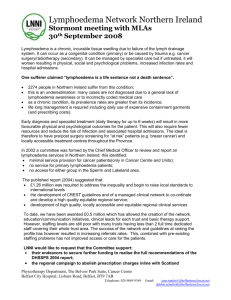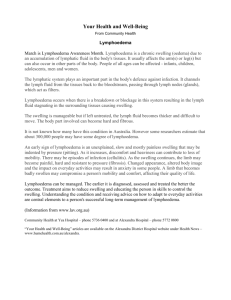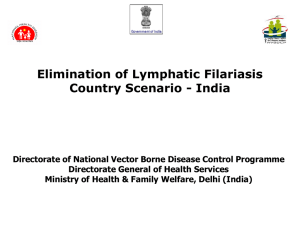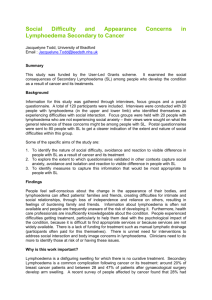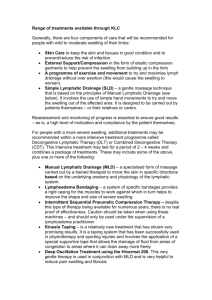Guidelines for elimination of Filariasis
advertisement
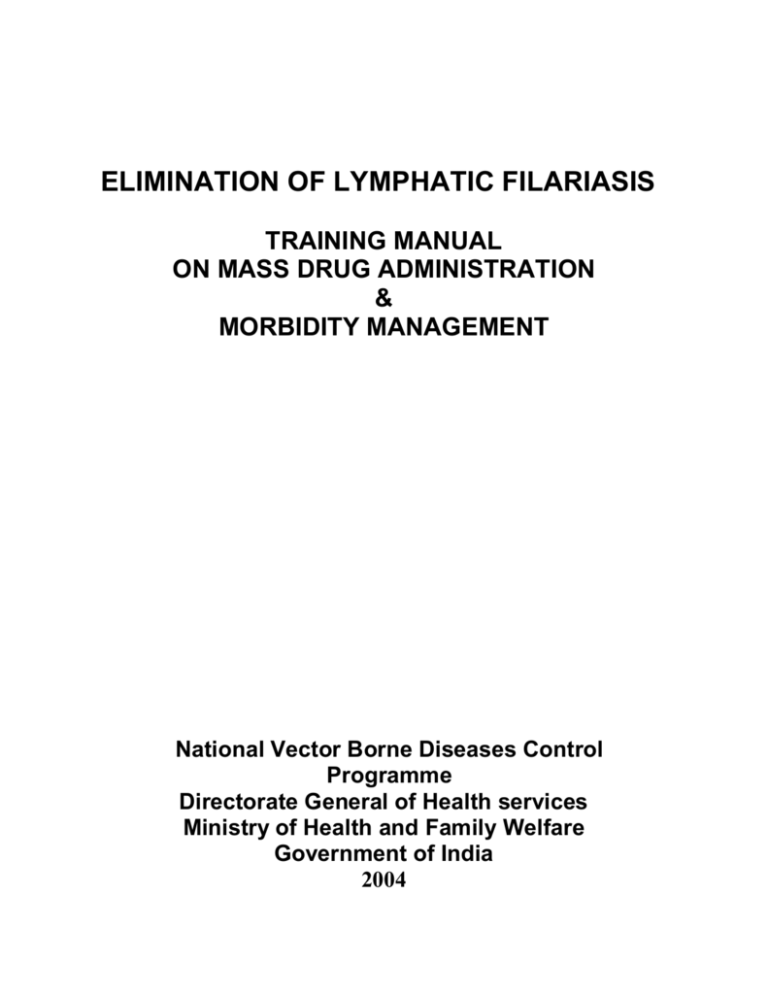
ELIMINATION OF LYMPHATIC FILARIASIS TRAINING MANUAL ON MASS DRUG ADMINISTRATION & MORBIDITY MANAGEMENT National Vector Borne Diseases Control Programme Directorate General of Health services Ministry of Health and Family Welfare Government of India 2004 CONTENTS Sl. No. Topic Page No. I Introduction: Lymphatic Filariasis 1 II National Goal of Elimination of LF 3 III Morbidity Survey 5 IV Mass Drug Administration 8 V Morbidity Management of Lymphoedema 11 VI Management of an Acute Attack of Infection 14 VII Breeding Places of Mosquitoes and Control measures 15 VIII Information, Education and Communication 16 Annex. 1 Line List of Filaria Patients 18 Annex. 2 State Action Plan 19 Annex. 3 Treatment and Use of Insecticide Treated Mosquito Nets Pre and Post-Test Paper & District Action Plan 23 25 I. LYMPHATIC FILARIASIS What is lymphatic filariasis (LF)? Lymphatic filariasis (LF), commonly known as elephantiasis, is a disfiguring, disabling disease, usually acquired in childhood. In the early stages there are either no symptoms or non-specific symptoms. Although there are no outward symptoms, the lymphatic system is damaged. This stage can last for several years. Infected persons sustain the transmission of the disease. The long term physical consequences are painful, swollen limbs (lymphoedema or elephantiasis). Everyday work becomes difficult due to frequent infections. Hydrocele in males is also common in endemic areas. Where do filarial parasites live inside the human body? The disease is caused by thread-like nematode parasites. In India, more than 98% of the cases are caused by the species - Wuchereria bancrofti. Indigenous cases have been reported from around 250 districts. In the adult stage, filarial worms live in the vessels of the lymphatic system. Lymphatic system is the network of nodes and vessels that maintains the fluid balance between the tissues and the blood and is an essential element of the body’s immune defense system. Macrofilaria, the adult stage How is Lymphatic Filariasis transmitted from one person to another? The adult produces millions of very small, immature larvae known as microfilariae, which circulate in the peripheral blood with marked nocturnal periodicity. The worms usually live and produce microfilariae for 4-6 years. Lymphatic filariasis is transmitted through mosquito bites. The microfilariae enter the body of a mosquito when it feeds on the blood of a person carrying microfilariae in their blood (mf carriers). It takes 7-21 days for the microfilariae to develop inside the body of the mosquito. Sh: Sheath, C.S.: Cephalic Space, N.R.: Nerve Ring, Ex.P.: Excretory Pore, Ex. C.: Excretory Cell, I.K.: Innerkorper, G.C. I & G.C. 2-4: G Cells (so-called “genital cells”), A.P.: Anal Pore, R.B.C.: Red Blood Cells, Neut.: Neutrophil, Eos.:Eosinophil, Lymph: Lymphocytes Laboratory Diagnosis Laboratory confirmation of diagnosis is necessary to identify asymptomatic patients and those with non-specific symptoms. Laboratory diagnosis is required to identify endemicity of the area and to document impact of MDA. The decision on whether to continue annual rounds of MDA will depend on the laboratory results. The main diagnostic test is the examination of night blood smear collected from 8.30 p.m. to 12 midnight. II. NATIONAL GOAL OF ELIMINATION OF LF 1. National goal The National Health Policy 2002 aims at Elimination of Lymphatic Filariasis by 2015. The strategy for achieving this goal is by annual mass drug administration of DEC once a year for at least 5 years to the entire population of an endemic district (excluding children under 2 years, pregnant women and severely ill patients) and morbidity management of lymphoedema. 2. Magnitude of the Disease Burden Indigenous cases have been reported from about 250 districts in 20 states/Union Territories. Cases of filariasis have been recorded from Andhra Pradesh, Assam, Bihar, Chhattisgarh, Goa, Jharkhand, Karnataka, Gujarat, Kerala, Madhya Pradesh, Maharashtra, Orissa, Tamil Nadu, Uttar Pradesh, West Bengal, Pondicherry, Andaman & Nicobar Islands, Daman & Diu, Dadra & Nagar Haveli and Lakshadweep. The disease is also reported in nearly 80 countries. The data available is largely based on information received from the Filaria Control Units (FCU) and Filaria Clinics as well as limited sample surveys carried out over a number of years. The data, while confirming the widespread distribution of lymphatic filariasis in India, has many limitations and cannot be used for estimating the disease burden, mf carrier rates or mf densities which are required for planning and monitoring of impact. Lymphatic Filariasis leads to life-long chronic complications such as lymphoedema and hydrocele. Due to a damaged lymphatic system, patients with lymphoedema have frequent attacks of infections causing high fever and severe pain. Patients may be bedridden for several days and normal routine activities become difficult. Such attacks not only cause acute physical suffering but also directly impact on the earning capacity of the individual. Lymphatic filariasis is estimated to be one of the leading causes of disability worldwide. Elimination of the disease is an important tool for poverty alleviation and economic development. The persons having circulating microfilariae are outwardly healthy but transmit the infection to others through mosquitoes. The persons with chronic filarial swellings suffer severely from the disease but no longer transmit the infection. 3. Strategies for Lymphatic Filariasis Elimination (LFE) The administration of a single dose of DEC reduces the rate and density of circulating microfilariae substantially for several months. The transmission of the disease can be interrupted if high levels of coverage in the affected communities are achieved on the same day annually for 5 to 7 years (life span of an adult worm). It is important to observe the consumption of the drug to ensure that the community takes the drugs. The efficacy of the MDA can be increased by administering the drug before the period of high vector breeding and by taking integrated vector control measures. MDA will not affect the condition of patients with lymphoedema or hydrocele. The community will therefore not see the benefits of MDA till several years later. The purpose of MDA must be clearly explained and the community should be informed that the MDA is to minimize the risks for their children and future generations. It is, however, essential that the health personnel in the peripheral facilities are trained in management of lymphoedema and are actively involved in creating awareness about the simple measures, which can be practised at home. The details are given at pages 14-16 of this manual. Morbidity management is an important measure for LFE. Hydrocele is relatively common in the endemic areas. Only a simple surgery is required. Hydrocoelectomy `camps’ can be considered in selected CHCs in areas where the prevalence is high. Publicity should be given to these camps so as to encourage patients to avail the services. III. MORBIDITY SURVEY 1. Lymphoedema Lymphoedema is due to dysfunction of the lymphatic vessels caused by the presence of the adult worms. It may take a few years to appear after the initial infection. It occurs more commonly in the lower extremities, but can also affect arms, scrotum, and breasts. The lymphoedema, if not treated, will progress till a patient becomes disabled and dependent. Repeated acute attacks will make the disease worse and increase the lymphoedema. 2. Line listing of cases Patients with lymphoedema are easily identifiable. The disease is commonly known as elephantiasis because of the swelling of the legs. The community, in which they live, is usually aware about them because the visible signs and the chronic nature of the complications. The local medical practitioners and the health facilities should also be aware since such patients seek frequent medical help due to repeated acute attacks of infection. The paramedical personnel can easily make a line list of all patients contacting key community representatives as well as extension workers or volunteers of the health and other departments. The line list should include the personal details such as age, sex, age at onset of symptoms and address. This information should be useful for morbidity management and for mapping out high risk areas for planning MDA and monitoring impact of services. The form for line listing is given at Annex 1. 3. Mapping out high risk areas and epidemiological analysis Given below is the list of patients identified through morbidity survey in Aamjora subcentre, Dumka district of Jharkhand. Exercise: Line list of patients: S. No. 1. 2. 3. 4. 5. 6. 7. 8. 9. 10. 11. 12. 13. 14. 15. 16. Name of the Patient Sunita Manoj Ram Gopal Shyam Hussain Meena Raghunath Pritam Singh Ganga Sangeeta Murti Singh Phool Kumari Raj Singh Anuj Pnadit Chote Singh Age of Patient (years) 30 82 60 36 30 30 38 55 50 40 30 45 55 50 35 24 Duration of Disease (years) 4 25 3 4 2 5 2 3 20 8 5 7 20 10 5 3 Sex Village F M M M M M F M M M F M F M M M D A C B A B B C D D A B A C C D A. Spot map of cases by residence Village C Village A Sub Centre Village D Village B B. List cases by year of onset Period 1980-85 1986-90 1991-95 1996-2000 2001 2002 No. of Cases C. Draw bar diagram of filarial cases by age Age Group: < 5 years, 5-14, 15-25, 26-50, >50 D. Draw bar diagram by sex IV. MASS DRUG ADMINISTRATION 1. Mass Drug Administration The transmission of infection can be stopped by treating the entire eligible population living in filarial endemic areas with Mass Drug Administration (MDA) with DEC given once a year for 5-7 years i.e. during the life span of adult filarial worm which gives birth to millions of microfilariae. With every treatment there will be a heavy reduction in the circulating microfilariae. This will markedly reduce or stop the transmission of the infection by the mosquitoes to other healthy persons 2. Diethylcarbamazine (DEC) DEC is available as 50 mg or 100 mg tablets. The drug has been in use in India for more than five decades. It is a safe drug at the recommended dose. The dose of DEC is 6 mg/kg body weight. The following dose schedule was being followed: Conventional Drug Schedule Age (in years) Dose of DEC <2 Nil 2-3 50 mg 4-5 100 mg 6-11 150 mg 12-17 200 mg >18 300 mg However, a simplified dose schedule was administered in Tamil Nadu for the mass drug administration campaigns. This was monitored by the state government and the Vector Control Research Centre (VCRC), ICMR and found to be safe and effective. The results were discussed by the National Task Force on Lymphatic Filariasis and the following simplified schedule has been recommended for MDA in the country: 3. Age (in years) DEC Dose <2 2-5 6-14 15 & above Nil 100 mg 200 mg 300 mg DEC (Tablets of 100 mg) Nil 1 tablet 2 tablets 3 tablets Side effects DEC at the above doses is safe. Persons with high mf density may experience general side effects in the form of headache, body ache, nausea and vomiting which result from the death of the microfilariae. The side effects are temporary and subside in a day or two after symptomatic treatment. Rarely, localized reactions in the form of swelling and tenderness of lymph nodes may occur. The community is made aware of the temporary side effects that may occur in 1 to 10% of the population who may be carriers of microfilariae. Persons with no mf or with very low levels of mf will not have any reactions. DEC should not preferably be taken on an empty stomach. 4. Contra-indications DEC is a safe drug. However, as a matter of precaution, it should not be given to children under two years and to pregnant women. Severely ill patients may also avoid taking the drug. 5. Preparatory activities for MDA There are several activities that must be done so that MDA is organized effectively and high levels of coverage are achieved. These activities include training of all concerned personnel, wide publicity and IEC, advocacy for intersectoral collaboration. Teams for MDA by door-to-door visits must be informed. Morbidity and sample night blood smear surveys must be completed. Arrangements must be made for the storage and distribution of DEC tablets. Intersectoral collaboration is essential. There are many employees of other government departments who are residents in endemic districts. Besides, the private sector organizations can play an active role in awareness generation and in ensuring coverage among their workforce and their families. Community leaders and representatives of the civil society can help in awareness generation and in motivating the community to take DEC tablets. They can also help in drug distribution alongwith the health personnel. Community leaders, private sector, NGOs, CBOs and self help groups should be encouraged to promote morbidity management in their areas. Action plans as per the proforma given at Annex 2 should be available at each level of the health infrastructure. 6. Drug distribution Make house-to-house visits. Booths may be set up in schools and workplace establishments. Each team should consist of a health worker and a community representative or a volunteer. Enquire about the family members and their age. Enter in the register. Explain the benefits of MDA and why it is important that all the eligible family members take DEC. Inform about the mild and transient side effects that may occur in persons who are mf carriers. Give the DEC tablets as per the age specific dose schedule. Request that the tablets be swallowed in the presence of the team. Make a repeat visit, if necessary, if some family members are absent or are severely ill and not able to take the drug. Do not administer the drug to children below two years of age, pregnant women and severely ill patients. Patients with lymphoedema and hydrocele should be advised about morbidity management and surgery. DEC tablets can be given. Conduct mopping up operation in the subsequent days to cover the inmates of locked households and also refusal cases through intensified IEC. Render the required assistance to persons experiencing side effects of drug. Inform subcentre/PHC about side effects. Report serious cases immediately to PHC Medical Officer. V. MORBIDITY MANAGEMENT OF LYMPHOEDEMA 1. Morbidity management Filaria patients with damaged lymphatic vessels often have more bacteria on the skin than usual. The large number of bacteria on the skin, multiple skin lesions, slow lymph fluid movement and the reduced ability of the lymph nodes to filter the bacteria cause inflammation characteristic of an acute attack. Repeated bacterial infections precipitate frequent acute attacks, which further damage the tiny lymphatic vessels in the skin, reducing their ability to drain fluid. This vicious cycle continues, aggravating the condition of the patient. Good hygiene and treatment of entry lesions are important measures for managing lymphoedema. The patients should be encouraged to practise skin care and hygiene and to use proper footwear. The reduction in the frequency of the acute attacks is an indication that the patient’s condition is improving. Effective, simple and cheap techniques have now been available to minimize the suffering caused by the acute and chronic manifestations of the disease A. Hygiene – Washing 1. Supplies needed: (i) Clean water at room temperature, (ii) Soap (least expensive soap without perfume is usually the best), (iii) Basin, (iv) Chair or Stool, (v) Towel, (vi) Footwear within easy reach. 2. Check skin for: (i) Entry lesions, including very small lesions between the toes that can hardly be seen, (ii) Entry lesions between the toes may cause itching. Scratching can further damage the skin and can provoke an acute attack; tell patients to avoid scratching, (iii) Toenails should be trimmed in such a way that the skin is not injured. Do not try to clean under the nails with sharp objects as these can cause entry lesions. It is important to check the skin every time the leg is washed because entry lesions allow bacteria to enter the skin and this will cause acute attacks. If entry lesions are found, they should be cleaned carefully. 3. Wash the leg: (i). Wet the leg with clean water at room temperature. Do not use hot water to wash the leg, (ii). Begin soaping at the highest point of swelling (usually around the knee), (iii). Wash down the leg towards the foot, (iv). Gently clean between all skin folds and between the toes, preferably using a small cloth or cotton swab, and paying particular attention to the entry lesions. Brushes should not be used as they can damage the skin, (v). Rinse with clean water, (vi). Repeat this careful washing until the rinse water is clean, (vii). Wash the other leg in the same way, even if it looks normal Washing and drying should be done daily ideally at night. Some patients may need to wash twice daily. 4. Dry the skin: (i). Pat the area lightly with a clean towel. Do not rub hard because this can cause damage to the skin, (ii). Carefully dry between the toes and between skin folds using a small cloth, gauze or cotton swab Wet areas between the toes, skin folds and entry lesions promote bacterial and fungal growth leading to frequent acute attacks. B. Prevention and cure of entry lesions 1. Entry lesions are common in patients with lymphoedema and are most frequently found between the toes and deep skin folds and around the toenails. Entry lesions, such as wounds, can also be found on the surface of the skin. Both fungi and bacteria can cause entry lesions. Fungal infections frequently damage the skin and create entry lesions, especially between the toes, and may cause itching. The entry lesions allow bacteria to enter the body through the skin and this can cause acute attacks. Fungi and bacteria can cause bad odour. 2. Fungal infections are usually white or pink in colour and do not leak fluid. Bacterial infections may leak fluid that is thin and clear or thick and coloured. 3. Antifungal and antibacterial creams can be used for local application. C. Elevation 1. Elevation is important for patients with lymphoedema of the leg. It helps prevent fluid from accumulating in the leg by improving the flow in the elevated position. 2. The knee should be slightly bent and a pillow placed under the knee for support. 3. While sitting, raise the foot as high as is comfortable, preferably as high as the hip. If sitting on the floor, place a small pillow under the knees. If lying down, the foot can be raised by placing a pillow under the mattress. Patients with heart problems should not elevate their legs unless advised by a doctor. D. Exercise 1. Exercise is useful for patients with lymphoedema and in general, the more they exercise the better they are. Exercise helps by pumping the fluid and improving drainage. However, patients should not exercise during acute attacks. 2. Besides walking short distances, simple exercises can be done. 2.1. Standing (up on the toes exercise): (i) Stand with both feet slightly apart, holding on to a wall, a person or other support, (ii) Raise on to the toes of both feet at the same time and then sink back down to flat feet, (iii) Repeat 5-15 times or as often as comfortable. If the patient is unable to rise on both feet at the same time, the exercise can be done one foot at a time. 2.2. Sitting or lying down (toe point exercise): (i) While sitting or lying down, point toes towards the floor, (ii) Then bend (extend) the toes upwards, (iii) Repeat 5-15 times or as often as comfortable, (iv) Repeat with the other leg 2.3. Sitting or lying down (circle exercise): (i) While sitting or lying down, move the foot in a circle to the right and to the left, (ii) Repeat with the other leg, (iii) If sitting on the floor, protect the heel with a flat pillow E. Wearing proper footwear Footwear protects feet from injury. Patients should avoid footwear that makes their feet hot and sweaty, or that are too tight. VI. MANAGEMENT OF AN ACUTE ATTACK OF INFECTION An acute attack of infection is painful. The patient may complain of fever, nausea, headache, pain in the affected limb and soreness of the lymph glands. Most patients can easily care for their acute attacks at home. Oral antibiotics can shorten the attack and are recommended, if the patient can be seen by a doctor. Paracetamol can be taken for fever every six hours until the fever lessens. A cloth soaked in water and placed around the leg can relieve pain. The leg can be soaked in a bucket of cold water. The leg should be washed with soap and clean water but more gently and carefully. After drying, antiseptic can be applied to the skin and medicated cream to any entry lesion. The patient should rest and elevate the leg comfortably as much as possible. It is advisable not to exercise during an acute attack as such exercise will be painful. The patient should drink plenty of water. Cold compress will help the patient. Patients, with any of the signs listed here, should be seen by a doctor: (i) Very high fever, confusion, headache, drowsiness or vomiting, (ii) Fever, shaking, chills, or pain in the leg that does not respond to treatment within 24 hours, (iii) Splitting of the skin because of rapid increase in the size of the leg, (iv) Pus in the affected area. Such patients must be treated under medical supervision. Implementation of self care and provision of service to the patient: For implementation of this methodology, you will be required to create the awareness about the benefits of morbidity management in the patients to prevent further worsening of the disease or development of disability. For this, you will participate in community education programmes. These programmes will carry the benefits of simple and effective local hygiene measures to the patients in periphery. VII. BREEDING PLACES OF MOSQUITOES AND CONTROL MEASURES 1. Filaria vectors Culex species of mosquitoes transmit filaria in India. Culex breeds in polluted water and common breeding sites are wet pit latrines, septic tanks, barrow pits, cess pools, drains, disused wells, paddy fields, etc. 2. Common methods of controlling mosquito breeding The control of breeding sites of Culex mosquitoes is relatively difficult due to the large number and variety of breeding sites. As a general rule, water should not be allowed to stagnate wherever possible by making drainage channels to drain water in agricultural fields, around hand pumps, etc. Water storage containers should be kept covered with tight fitting lids. Pipes leading into or out of tanks should be properly sealed or covered with netting material to prevent entry of mosquitoes. Guppy and gambusia fish should be put in unusued wells and other water bodies. The community should be encouraged to use mosquito nets. If use of mosquito net is already high, community should be encouraged to treat their nets with insecticides by organizing `mosquito net dipping camps’. The procedure for treating mosquito nets is given at Annex 3. VIII. INFORMATION, EDUCATION AND COMMUNICATION (IEC) Health education is to make the community to understand the importance of MDA and morbidity management and to get their active cooperation. People should be presented with information that they can understand. Facts should be presented in familiar words. The importance of taking DEC to interrupt the transmission of the disease shall be explained. The community shall get a positive message about the lymphatic filariasis elimination campaign. 1. Key message on MDA It is important to explain that the `elephant foot’ is a late manifestation of a disease, which is usually acquired in childhood. The disease is spread through the bites of mosquitoes. Even if people feel well, they may be infected by the parasite and can develop the disease later. The parasites in them will spread the disease to others through the mosquitoes. If the whole community takes DEC, the microfilariae in the blood will be killed and the mosquitoes will no longer spread the disease. Explain that the next generation will be free from the disease. Explain also that unless everybody takes the drug, the disease will continue to spread. The community should be convinced that DEC is safe. DEC at the above doses is safe. Persons with high mf density may experience general side effects in the form of headache, body ache, nausea and vomiting which result from the death of the microfilariae. The side effects are temporary and subside in a day or two after symptomatic treatment. Rarely, localized reactions in the form of swelling and tenderness of lymph nodes may occur. Persons with no mf or with very low levels of mf will not have any reactions. DEC should not preferably be taken on an empty stomach. It is important that the need for everybody to take DEC and that it is safe is explained carefully to the community representatives and to the families. Experience in Kerala and Tamil Nadu has shown that less than 2% of the people who took the drug had some mild reaction. However, fear of side reactions was a major cause of non-compliance. The community must also know that the mass drug administration with DEC will not cure the chronic complications such as lymphoedema and hydrocoele. If there are patients in the family they should be advised about foot hygiene and simple exercises. If camps for hydrocoelectomy are being organized, the dates can be intimated. 2. Key message on Morbidity Management Demonstrate the correct method for washing the affected part with ordinary soap and water at room temperature every day. In other words, people who are affected by the disease (for example with swollen limbs) will have to practise morbidity management every day to prevent recurring acute attacks of fever and pain. 3. Key message on Mosquito Breeding and Control Filaria causing mosquitoes breed in polluted water and the domestic breeding sites should be eliminated. The community shall be educated about the benefits of larvivorous fish like Guppy and regular use insecticide treated mosquito bed nets. 4. Salient Methods of IEC Group discussion Role play Distribution of bills, posters, etc. Demonstration on morbidity management Demonstration on the correct use of insecticide treated mosquito bed nets IX. GUIDELINES ON PRACTICALS, DEMONSTRATIONS, GROUP DISCUSSIONS AND ROLE-PLAY 1. Practical Group Demonstration on Morbidity Management Door to door filaria survey (day time) may be conducted one week before the training to select sufficient number of lymphodema cases for practical demonstration. Ideally, one trainee could attend on one patient. If the number of patients is less, 2 to 4 trainees may attend on one patient. The place of residence of patients shall be as near as possible to the training centre. All the material needed for foot hygiene with supply of clean water may be ensured during practical demonstration. All the five components of lymphodema morbidity management namely (i) washing, (ii) prevention and cure of entry lesions, (iii) elevation of food, (iv) exercises and (v) use of proper footwear should be demonstrated. The trainees may be given a pair of disposable gloves for washing the lymphoedema limbs. 2. Role play and group discussion Role play on each aspect namely (i) MDA, (ii) Line-listing of filaria cases, (iii) Source reduction of mosquitoes and (iv) use of insecticide impregnated bed nets should be conducted within the allotted time-frame. Different batches of trainees will perform the role pay. The faculty will prepare the trainees for the plausible questions posed by the community. MDA - The role-play for MDA can be enacted for different situations as given below: a) Cooperative Household. One trainee will play the role of drug distributor while four trainees will act as community members - one as head of the family, another as female member of household while the other two act as if they were kids of different age groups. The drug distributor will verify the names in the “so-called register” and their ages before administering “DEC 100 mg” tablets as per their age. (The “DEC 100 mg” tablets could be real or placebo). The drug distributor should ask whether anybody is severely ill so as to exclude them from MDA. S/He should also put questions whether any food has been taken since DEC is not to be administered on empty stomach. The drug should be swallowed in the presence of the drug distributor who will also inform them about mild side-affects among microfilaria carriers which will be transitory and could be treated with remedial drugs available at sub-centre/PHC. b) Resistant Household: In the second part of role-play on MDA, the drug distributor and community members may be chosen from another set of trainees. The preliminary enquiry shall be done as mentioned above. The community members will put a lot of plausible questions about the usefulness of MDA. The drug distributor will have to win their confidence with convincing answers. The questions or answers are to be left to the imagination of role-players. In the end the rest of the trainees and faculty will suggest improvements in overcoming community resistance. c) Line-Listing of Filaria cases: Three or four participants will present their “so called report” of morbidity survey and line-listing of filaria cases in the tabulated form for each village and consolidated report for the sub-centre. The report should provide evidence of filariasis transmission currently so as to justify MDA in the area. The reasons for presence or absence of filaria transmission may be highlighted in the presentation. d) Source Reduction: Each trainee may identify different types of mosquito breeding sources, which can be eliminated or prevented. The list may run into large types of common mosquito breeding sources, which can be eliminated, by the individuals, householders and community at large. The sessions could be made very interactive and highly interesting when the group discusses among themselves with bare minimum inputs from the faculty. Morbidity management: Hands on training or patients PRE-TEST / POST-TEST NAME OF THE PARTICIPANT:………………………………………………………………………… DESIGNATION:…………………………………………………………………………………………….. POSTAL ADDRESS:…………………………………………………………………………………….. ……………………………………………………………………………………… I. MULTIPLE CHOICE QUESTIONS: Tick (√ ) the correct answers Marks: 45 1. How is filaria transmitted? a. b. c. d. 2. a. a. b. c. Contaminated drinking water Polluted air Mosquito bite Sexual contact Which of the following are the long-term complications of filarial? High blood pressure Swelling of the leg(s) [lymphoedema]/ hydrocele Frequent acute attacks of infection of the affected leg(s) Diabetes 3. What is the recommended strategy for lymphatic filariasis elimination? a. b. c. d. 12 day course of DEC of patients who come for treatment Night blood survey and 12 day treatment of those found positive Mass drug administration of eligible population of endemic areas once a year Mass drug administration of the eligible population of endemic areas once a year for 5 years 4. a. b. c. d. 5. a. b. c. d. Why is the elimination goal important? The disease is one of the leading causes of preventable disability It will help in poverty alleviation and economic development in endemic areas It will alleviate the suffering of people who already have the lymphoedema/ hydrocele It will improve intersectoral collaboration and health seeking behaviour Who are eligible for drug administration? All the population of the entire district School going children The entire population except children under two years and pregnant women The entire population up to 40 years of age, except children under two and pregnant women 6. a. b. c. 3 d. 7. a. b. c. d. 8. a. b. c. d. 9. a. b. c. d. What is the recommended dose of DEC for MDA? One tablet (100 mg) of DEC to all age groups 6 mg/ kg body weight One tablet (100 mg) for children 2 to 4 years, 2 tablets for children 5 to 14 years and tablets to ≥ 15 years Two tablets (100 mg each) to all age groups How is the magnitude of the disease burden estimated? Estimates based on patients visiting the Filaria Control Units and Filaria Clinics Limited surveys of night blood smears Morbidity survey and line listing of all patients of lymphoedema and hydrocele Random sample surveys of night blood smears What are the recommended guidelines for the treatment of lymphoedema? 12 day course of DEC, repeated at 6 monthly intervals One doe of DEC repeated at fortnightly intervals Treatment with antibiotics (oral) and application of ointment Foot hygiene and simple exercises When filaria blood smear survey is carried out? Early in the morning During afternoon At night Any time of the day II. TRUE OR FALSE Marks: 20 1. 2. 3. 4. TRUE / FALSE TRUE / FALSE TRUE / FALSE TRUE / FALSE Culex female mosquitoes transmit filaria infection Filaria is a communicable disease Water collections facilitate mosquito breeding Regular use of mosquito bed nets prevents filarial infection III. MATCH THE FOLLOWING Marks: 20 1. Malaria A. Aspirin 2. Filaria B Chloroquine 3. Headache C Paracetamol 4. Fever D DEC IV. IDENTIFY THE FOLLOWING DISEASES 1. Kala-azar 2. Polio Marks: 15 3. Filaria Total Marks: 100 Annex. 1 LINE LIST OF FILARIA PATIENTS District: Sl. No. PHC: Name of Patient Sub-centre: Village: Name of Head of family & address Age (Years) Population of village: Sex (F/M) Lymphoedema Date of survey: Hydrocele (one form for each village) * Mention separately if period of stay in district is less than 6 months Year when* symptoms appeared Annex. 2 NATIONAL FILARIA DAY STATE ACTION PLAN Sl. No . ACTIVITY 1. DEC requirement 2. Baseline data collection ACTIVITY BREAK-UP IEC ADVOCA CY RESPONSIBLE OFFICER PRE MASS DRUG ADMINISTRATION Requirement district-wise Arrangements for storage and distribution System of tracking of supplies and utilization . Morbidity Survey Identification of personnel and area for coverage Training programmes Printing of forms Monitoring of progress Night Blood Survey Identification of personnel and area for coverage Training programmes Printing of forms Procurement of supplies Selection of sites IEC activities for community participation Monitoring of progress 3 SCHEDULE Identification of high risk pockets by morbidity survey District-wise mf carrier rate and density Prepare IEC material in local language Print Despatch to districts Prepare other IEC material Contract concerned agencies Intersectoral meetings . COST PROCES S AND ERFOR MANCE INDICA TOR Advocacy workshops 3 Training of trainers Training District level training on MDA and morbidity management Training on night blood survey Training of drug distributors 4 District-wise facilities providing Morbidity Manageme appropriate treatment District-wise camps organized nt for creating awareness Number of patients trained 5 Hydrocelec Identifications of CHCs districtwise tomy No. of camps camps Informing the public 6. Identification of teams for drug Drug distribution distribution Identification of booths in captive places such as schools, workplaces, etc 7. District-wise allocation and Funds release of funds B MASS DRUG ADMINSTRATION ON 5 JUNE 1. Monitoring of field visits Drug distribution Receipt of returns 2. Mopping up Mopping up 3. Hydrocelec District-wise number of camps No. of patients operated tomy camps C POST MASS DRUG ADMINISTRATION 1 Performan Review coverage Side effects ce 2. Organizati Review logistical arrangements on Annex. 2 NATIONAL FILARIA DAY DISTRICT ACTION PLAN Sl. No . ACTIVITY 1. DEC requirement 2. Baseline data collection ACTIVITY BREAK-UP IEC ADVOCACY 3 Training RESPONSIBL E OFFICER PRE MASS DRUG ADMINISTRATION Requirement PHC wise Arrangements for storage and distribution System of tracking of supplies and utilization . Morbidity Survey Identification of personnel and area for coverage Training programmes Printing of forms Monitoring of progress Night Blood Survey Identification of personnel and area for coverage Training programmes Printing of forms Procurement of supplies Selection of sites IEC activities for community participation Monitoring of progress 3 SCHEDULE Identification of high risk pockets by morbidity survey District-wise mf carrier rate and density Prepare IEC material in local language Print Despatch to PHCs Prepare other IEC material Contract concerned agencies Intersectoral meetings Advocacy workshops Training of trainers PHC level training on MDA and morbidity management Training on night blood survey Training of drug distributors . COS 4 PHC-wise facilities providing appropriate treatment PHC-wise camps organized for creating awareness Number of patients trained 5 Identifications of CHCs Hydrocelectomy No. of camps camps Informing the public 6. Identification of teams for drug Drug distribution distribution Identification of booths in captive places such as schools, workplaces etc 7. PHC wise allocation and release of funds Funds B MASS DRUG ADMINSTRATION ON 5 JUNE 1. Monitoring of field visits Drug distribution Receipt of returns 2. Mopping up Mopping up 3. PHC-wise number of camps Hydrocelectomy No. of patients operated camps C POST-MASS DRUG ADMINISTRATION 1 Review coverage Performance Side effects 2. Review logistical arrangements Organization Morbidity Management Annex. 3 TREATMENT AND USE OF INSECTICIDE-TREATED MOSQUITO NETS Why use Insecticide-Treated Mosquito Nets? Malaria and certain other diseases are transmitted by the bite of mosquitoes. Pregnant women, babies and young children are at the greatest risk of dying of malaria. Ordinary untreated mosquito nets provide limited physical barrier between mosquito and man and protection as they may still bite through the net or get inside the net following improper use. Mosquito nets treated with insecticides provide better and effective protection by keeping away mosquitoes as well as killing them. An insecticide-treated mosquito net also kills or keeps away other nuisance insects – cockroaches, bedbugs, houseflies, fleas, etc. How to treat the net – 10 Easy Steps for Mass Treatment Mass treatment is done at fixed/designated sites. Insecticide treatment is recommended for synthetic nets (nylon, polyester), as treatment of cotton nets is not cost-effective and effect of insecticide is not long lasting. Step 1: Collect the necessary equipment The necessary equipment consists of: mosquito nets, insecticide, basin, measuring container, rubber gloves, soap. Make sure the net is washed/cleaned before treatment. Preferably, nets should be treated outdoors in the shade. If treatment is to be carried out indoors, a room with open windows should be used. Use basin, gloves that are not used for any other purpose. Step 2: Put on protective gloves before treating nets Step 3: Measure the correct amount of water The amount of water needed depends on the net material. Regardless of the size and shape of net, the amount of water required for: One synthetic net (nylon, polyester) – ½ litre (if the net is very large, more water may be needed). If measuring container comes with insecticide, use it to measure water. Otherwise, use any measuring container, that is not used for food, drinks, medicines. Step 4: Measure the correct amount of insecticide The amount of insecticide or “dose” needed to treat a net depends on type of insecticide used. Follow instructions on the container, sachet, packet. Generally, 10-15 ml of insecticide is required to treat one net. [BIS Number of Liquid Synthetic Pyrethroid used for treatment of Bed Nets i) Deltamethrin – IS14411: 1996; ii) Cyfluthrin – IS14156: 1994]. Store leftover insecticide in its original container, in the dark and away from children. Step 5: Mix the water and insecticide thoroughly by gloved hands in basin Step 6: Treatment of nets Always treat one net at a time. Put the net in the basin containing water and insecticide. Soak the net long enough to ensure that all parts of the nets are impregnated. Take out the nets and allow excess liquid to drip back. Do not wring the treated net. Step 7: Drying the nets Let the net dry flat in the shade on plastic sheets. Later, the net can be hung up to finish drying in the shade. Step 8: Disposal of leftover mixture of water and insecticide and insecticide containers Following treatment of all available nets, leftover mixture of water and insecticide, if any, may be used to treat curtains. Otherwise, dispose the liquid in the toilet or a hole away from habitation, animal shelters, drinking water sources, ponds, rivers, streams. Destroy empty insecticide containers, sachets, packets and/or bury in a hole away from habitation, animal shelters, drinking water sources, ponds, rivers, streams. Step 9: Washing and cleaning of hands, equipments Wash equipments (basin, measuring container) with lots of water while wearing protective gloves. Wash gloves (if non-disposable ones are used)] with soap and lots of water, or dispose with insecticide containers. Wash hands with soap and lots of water. Step 10: Washing and re-treatment of nets Washing removes insecticide from the net. So, wash the nets as seldom as possible and gently with soap and cold water and dry flat on plastic sheet in shade. Do not wash/rinse treated net in or near drinking water sources, ponds, lakes, rivers, streams. Dispose of water for washing/rinsing in the toilet or in a hole away from habitation, animal shelters, drinking water sources, ponds, rivers, streams Nets must be re-treated again after it has been washed three times. Or, at least once a year even if it is not washed, preferably just before the rainy season. Nets may be treated twice a year in areas that have a lot of mosquitoes all year long. Remember: Use the insecticide-treated net every night, all year round, even if mosquitoes are not seen/heard. Preferably, everyone should sleep under a treated mosquito net. Or, at least pregnant women and children under five years must sleep under treated net. Insecticides used for mosquito nets are not harmful to people, if used correctly. Direct skin contact with the insecticide on a still wet net may cause a tingling sensation on the skin. This is not harmful, even for small children. After treatment, the net may smell of insecticide. This will go away in a few days and is not harmful to people who sleep under the net.
